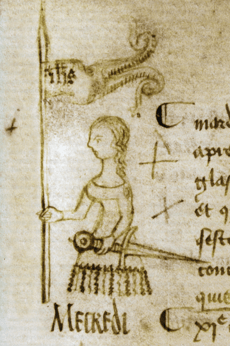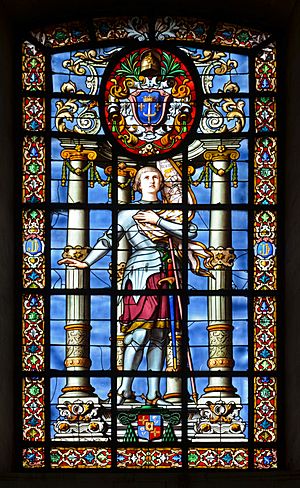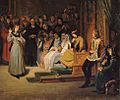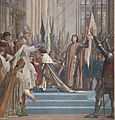Joan of Arc facts for kids
Quick facts for kids SaintJoan of Arc |
|
|---|---|
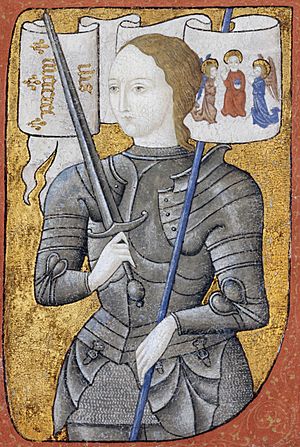
Historiated initial depicting Joan (dated to the second half of the 15th century, Archives Nationales, Paris, AE II 2490)
|
|
| Virgin | |
| Born | c. 1412 Domrémy, Duchy of Bar, Kingdom of France |
| Died | 30 May 1431 (aged c. 19) Rouen, Normandy (then under English rule) |
| Venerated in | |
| Beatified | 18 April 1909 by Pope Pius X |
| Canonized | 16 May 1920 by Pope Benedict XV |
| Feast | 30 May |
| Patronage | France |
Joan of Arc (6 January c. 1412 – 30 May 1431), nicknamed "The Maid of Orléans", is considered a heroine of France for her role during the Lancastrian phase of the Hundred Years' War, and was canonized as a Roman Catholic saint. She was born to Jacques d'Arc and Isabelle Romée, a peasant family, at Domrémy in north-east France.
Joan of Arc is one of the nine secondary patron saints of France, along with Saint Denis, Saint Martin of Tours, Saint Louis, Saint Michael, Saint Rémi, Saint Petronilla, Saint Radegund and Saint Thérèse of Lisieux.
Joan of Arc has remained a popular figure in literature, painting, sculpture, and other cultural works since the time of her death, and many famous writers, playwrights, filmmakers, artists, and composers have created, and continue to create, cultural depictions of her.
Contents
Name
Joan of Arc's name was written in a variety of ways. There is no standard spelling of her name before the sixteenth century; her last name was usually written as "Darc" without an apostrophe, but there are variants such as "Tarc", "Dart" or "Day". Her father's name was written as "Tart" at her trial. She was called "Jeanne d'Ay de Domrémy" in Charles VII's 1429 letter granting her a coat of arms. Joan may never have heard herself called "Jeanne d'Arc". The first written record of her being called by this name is in 1455, 24 years after her death.
She was not taught to read and write in her childhood, and so dictated her letters. She may have later learned to sign her name, as some of her letters are signed, and she may even have learned to read. Joan referred to herself in the letters as Jeanne la Pucelle ("Joan the Maiden") or as la Pucelle ("the Maiden"), and she signed "Jehanne". In the sixteenth century, she became known as the "Maid of Orleans".
Birth and historical background
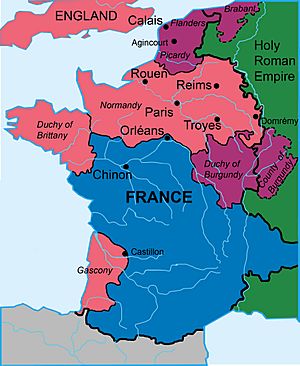
Controlled by Henry VI of England Controlled by Philip III of Burgundy Controlled by Charles VII of France
Joan of Arc was born around 1412 in Domrémy, a small village in the Meuse valley now in the Vosges department in the north-east of France. She was born during the Hundred Years' War between England and France, which had begun in 1337 over the status of English territories in France and English claims to the French throne. Nearly all the fighting had taken place in France, devastating its economy. At the time of Joan's birth, France was divided politically. The French king Charles VI had recurring bouts of mental illness and was often unable to rule; his brother Louis, Duke of Orléans, and his cousin John the Fearless, Duke of Burgundy, quarreled over the regency of France. In 1407, the Duke of Burgundy ordered the assassination of the Duke of Orléans, precipitating a civil war. Charles of Orléans succeeded his father as duke at the age of thirteen and was placed in the custody of Bernard, Count of Armagnac; his supporters became known as "Armagnacs", while supporters of the Duke of Burgundy became known as "Burgundians". The future French king Charles VII had assumed the title of Dauphin (heir to the throne) after the deaths of his four older brothers and was associated with the Armagnacs.
Henry V of England exploited France's internal divisions when he invaded in 1415. The Burgundians took Paris in 1418. In 1419, the Dauphin offered a truce to negotiate peace with the Duke of Burgundy, but the duke was assassinated by Charles's Armagnac partisans during the negotiations. The new duke of Burgundy, Philip the Good, allied with the English. Charles VI accused the Dauphin of murdering the Duke of Burgundy and declared him unfit to inherit the French throne. During a period of illness, Charles's wife Isabeau of Bavaria stood in for him and signed the Treaty of Troyes, which gave their daughter Catherine of Valois in marriage to Henry V, granted the succession of the French throne to their heirs, and effectively disinherited the Dauphin. In 1422, Henry V and Charles VI died within two months of each other; the 9-month-old Henry VI of England was the nominal heir of the Anglo-French dual monarchy as agreed in the treaty, but the Dauphin also claimed the French throne.
Early life
In her youth, Joan did household chores, spun wool, helped her father in the fields and looked after their animals. Her mother provided Joan's religious education. Much of Domrémy lay in the Duchy of Bar, whose precise feudal status was unclear; though surrounded by pro-Burgundian lands, its people were loyal to the Armagnac cause. By 1419, the war had affected the area, and in 1425, Domrémy was attacked and cattle were stolen. This led to a sentiment among villagers that the English must be expelled from France to achieve peace. Joan had her first vision after this raid.
Joan later testified that when she was thirteen, around 1425, a figure she identified as Saint Michael surrounded by angels appeared to her in the garden. After this vision, she said she wept because she wanted them to take her with them. Throughout her life, she had visions of St. Michael, a patron saint of the Domrémy area who was seen as a defender of France. She stated that she had these visions frequently and that she often had them when the church bells were rung.
During Joan's youth, a prophecy circulating in the French countryside, based on the visions of Marie Robine of Avignon, promised an armed virgin would come forth to save France. Another prophecy, attributed to Merlin, stated that a virgin carrying a banner would put an end to France's suffering. Joan implied she was this promised maiden, reminding the people around her that there was a saying that France would be destroyed by a woman but would be restored by a virgin. In May 1428, she asked her uncle to take her to the nearby town of Vaucouleurs, where she petitioned the garrison commander, Robert de Baudricourt, for an armed escort to the Armagnac court at Chinon. Baudricourt harshly refused and sent her home. In July, Domrémy was raided by Burgundian forces which set fire to the town, destroyed the crops, and forced Joan, her family and the other townspeople to flee. She returned to Vaucouleurs in January 1429. Her petition was refused again, but by this time she had gained the support of two of Baudricourt's soldiers, Jean de Metz and Bertrand de Poulengy. Meanwhile, she was summoned to Nancy under safe conduct by Charles II, Duke of Lorraine, who had heard about Joan during her stay at Vaucouleurs. The duke was ill and thought she might have supernatural powers that could cure him. She offered no cures, but reprimanded him for living with his mistress.
Henry V's brothers, John of Lancaster, 1st Duke of Bedford, and Humphrey, Duke of Gloucester, had continued the English conquest of France. Most of northern France, Paris, and parts of southwestern France were under Anglo-Burgundian control. The Burgundians controlled Reims, the traditional site for the coronation of French kings; Charles had not yet been crowned, and doing so at Reims would help legitimize his claim to the throne. In July 1428, the English had started to surround Orléans and had nearly isolated it from the rest of Charles's territory by capturing many of the smaller bridge towns on the Loire River. Orléans was strategically important as the last obstacle to an assault on the remainder of Charles's territory. According to Joan's later testimony, it was around this period that her visions told her to leave Domrémy to help the Dauphin Charles. Baudricourt agreed to a third meeting with Joan in February 1429, around the time the English captured an Armagnac relief convoy at the Battle of the Herrings during the Siege of Orléans. Their conversations, along with Metz and Poulengy's support, convinced Baudricourt to allow her to go to Chinon for an audience with the Dauphin. Joan traveled with an escort of six soldiers. Before leaving, Joan put on men's clothes, which were provided by her escorts and the people of Vaucouleurs. She continued to wear men's clothes for the remainder of her life.
Military campaigns
Charles VII met Joan for the first time at the Royal Court in Chinon in late February or early March 1429, when she was seventeen and he was twenty-six. She told him that she had come to raise the siege of Orléans and to lead him to Reims for his coronation. They had a private exchange that made a strong impression on Charles.
Charles VII sent Joan to the siege of Orléans as part of a relief mission. She gained prominence after the siege was lifted only nine days later. Several additional swift victories led to Charles VII's coronation at Reims. This long-awaited event boosted French morale and paved the way for the final French victory. Joan was ennobled by Charles as a reward for her services to him and the kingdom.
Capture, trial and death
On 23 May 1430, she was captured at Compiègne by the Burgundian faction, a group of French nobles allied with the English. She was later handed over to the English and put on trial by the pro-English bishop Pierre Cauchon on a variety of charges. After Cauchon declared her guilty she was burned at the stake on 30 May 1431, dying at about nineteen years of age.
In 1456, an inquisitorial court authorized by Pope Callixtus III examined the trial, exposed the falseness of the charges against her, pronounced her innocent, and declared her a martyr. In the 16th century she became a symbol of the Catholic League, and in 1803 she was declared a national symbol of France by the decision of Napoleon Bonaparte. She was beatified in 1909 and canonized in 1920.
Legacy
Joan of Arc became a semi-legendary figure for the four centuries after her death. The main sources of information about her were chronicles. Five original manuscripts of her condemnation trial surfaced in old archives during the 19th century. Soon, historians also located the complete records of her rehabilitation trial, which contained sworn testimony from 115 witnesses, and the original French notes for the Latin condemnation trial transcript. Various contemporary letters also emerged, three of which carry the signature Jehanne in the unsteady hand of a person learning to write. This unusual wealth of primary source material is one reason DeVries declares, "No person of the Middle Ages, male or female, has been the subject of more study." Joan of Arc came from an obscure village and rose to prominence when she was a teenager, and she did so as an uneducated peasant.
From Christine de Pizan to the present, women have looked to Joan as a positive example of a brave and active woman. She operated within a religious tradition that believed an exceptional person from any level of society might receive a divine calling. Some of her most significant aid came from women.
Three separate vessels of the French Navy have been named after her, including a helicopter carrier that was retired from active service on 7 June 2010. At present, the French far-right political party Front National holds rallies at her statues, reproduces her image in the party's publications, and uses a tricolor flame partly symbolic of her martyrdom as its emblem. This party's opponents sometimes satirize its appropriation of her image. The French civic holiday in her honour, set in 1920, is the second Sunday of May.
World War I songs include "Joan of Arc, They Are Calling You", and "Joan of Arc's Answer Song".
Patronage
- France; martyrs; captives; military personnel; people ridiculed for their piety; prisoners; soldiers, women who have served in the WAVES (Women Accepted for Volunteer Emergency Service); and Women's Army Corps
Images for kids
-
Joan's birthplace in Domrémy is now a museum. The village church where she attended Mass is to the right, behind the trees.
-
Detail of Joan of Arc, in front of Charls VII, responds to the prelates who question her by Gillot Saint-Evre (1832, Louvre)
-
Joan of Arc interrogated in prison by the Cardinal of Winchester, by Hippolyte Delaroche (1824, Musée des Beaux-Arts)
-
Joan of Arc's Death at the Stake, by Hermann Stilke (1843, Hermitage Museum)
-
Joan of Arc in armor, from the New Orleans copy of statue Jeanne d'Arc by Emmanuel Frémiet (original 1874, Place des Pyramides)
See also
 In Spanish: Juana de Arco para niños
In Spanish: Juana de Arco para niños


